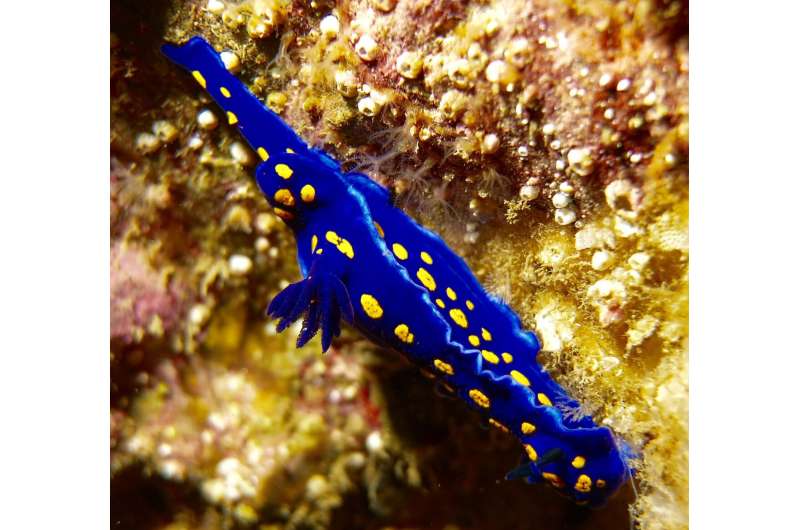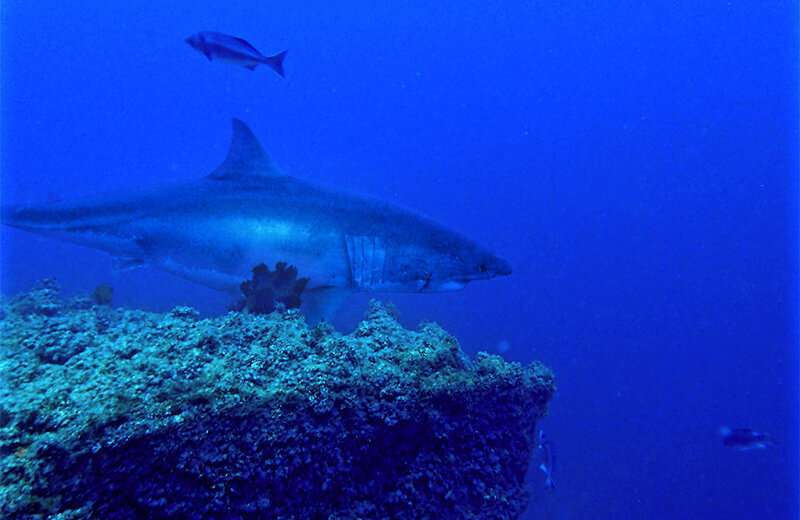Study of nature preserve reveals more than 1,000 species and signs of changing oceans

Blue Cavern Point on the eastern edge of Santa Catalina Island, some 25 miles off the coast of San Pedro, California, is a hotbed of life. In the shallow edges of the water cling starfish, sea urchins and sea cucumbers. Farther out in deeper seas, bright orange garibaldi and giant sea bass the size of pianos make their home in rippling forests of giant kelp reaching hundreds of feet from the ocean's surface to its floor.
The area is divided into two protected areas: offshore and onshore. The onshore region encompasses the first three square miles of the preserve. Its offshore area reaches out about eight miles into deeper ocean. Since 1988, the area has been fiercely protected from fishing or specimen collection.
Despite this area's exceptional biodiversity, no one had completed a comprehensive survey of all the creatures that call these waters home. In 2015, David Ginsburg, professor (teaching) of environmental studies at the USC Dornsife College of Letters, Arts and Sciences, and Audrey Looby, then an undergraduate majoring in environmental studies, set out to change that.
Their study, "Nearshore Species Biodiversity of a Marine Protected Area Off Santa Catalina, Island, California," an inventory all of the species of this unique preserve, was published in the March 2021 edition of Western North American Naturalist.
They documented more than 1,000 different kinds of marine macroalgae, plants, invertebrates and fishes. Their research also revealed that human activity and climate change appear to be altering these pristine waters.
Partners in cataloging
Their project was first inspired by a routine environmental impact inspection of the USC Wrigley Marine Science Center on Catalina Island, where a pipe funnels seawater through the lab's aquariums and back into nearby Big Fisherman's Cove.
As the inspection process began, Ginsburg soon discovered that no complete inventory of the marine life inhabiting the area existed. This posed a problem.
"Here you have this marine-protected area and you're supposed to know what's in there, but no one really knows," says Ginsburg. Only a scattering of research papers or incomplete catalogs gave an idea of the biodiversity. His interest in undertaking a more comprehensive survey was piqued.
The scope of the project was intimidating, however. Cataloging every species would require both diving for specimens and diving into archives. Simply surveying the present environment would not capture the full spectrum of what lived in the point. Some species passed in and out of the cove, were seasonal or perhaps so endangered they were rare to find in the present day. He'd have to go back and find everything that had ever been recorded in the area.
"I talked to a lot of people about this," says Ginsburg. "My friend Gordon Hendler [curator of echinoderms] at the Natural History Museum of Los Angeles said, "You'll never find a stopping point.'" Hendler encouraged Ginsburg to pursue the project with a more realistic goal of cataloging as much as he could, given that anything would be an improvement.
Luckily, Ginsburg would not have to go it alone. Looby received a Research Summer Undergraduate internship at the USC Wrigley Institute for Environmental Studies, headquartered at USC Dornsife. She would be spending the summer on the island and readily agreed to assist with Ginsburg's plans. Perhaps, between the two of them, such a complex study had a chance for completion.

Under the sea (and into the archives)
Looby's enthusiasm was due in part to her new-found love of diving. She'd become certified thanks to USC's AAUS Scientific Diving Course and was eager to get as much time in the water as possible.
Exploring life bobbing beneath the water line was like encountering a different planet, says Looby. A neon nudibranch, a mollusc so vivid it could easily be mistaken for a Salvador Dali invention, twisted along algae covered rocks. Stingrays glided through the currents.
"The first time you see them, you suddenly see the ground moving underneath you and there's a whole fever of rays swimming along," says Looby, who is now a fisheries and aquatic sciences Ph.D. student at the University of Florida.
Ginsburg and Looby completed visual surveys of five intertidal reefs around the point, meticulously identifying and recording everything from the smallest microalgae on up to those piano-sized bass.
Some of their encounters were newsworthy. On Looby's last dive of the summer, she and her fellow divers sighted a 15-foot, pregnant great white shark, one of only a handful of sightings ever recorded in the area.
The project also required less adventurous work. The duo scoured thousands of pages of documents from 1960 to the present for recordings of specimens sighted in the area. Resources included old research papers, museum and herbarium specimen records and citizen science recordings.
From these efforts, the list of specimens sighted in the cove reached some 1,100 unique species all within the less than three square miles of the preserve.
Shifting seas
Ginsburg and Looby's work also produced more ominous findings—how human hands are changing the cove, despite protective efforts
Some changes are more benign than others. As they perused studies, they discovered that there was no mention of sea grasses, or any of the species that typically live among the grasses, prior to the 1990s.
"The leopard sharks and the rays that Catalina divers remember probably weren't here before the dock," says Ginsburg. "That was another part of the story that I really thought was cool. It's not just about naming all the species; it's also about recording some really big ecosystem shifts."
Other discoveries were bleaker. The Dali-esque nudibranch, for example, has declined severely in number, likely due to pollution and collecting for home aquariums. Sea stars like the bat star and spiny star, despite frequent recordings in past surveys, weren't found on their dives. Unusual sightings of subtropical species like the finescale triggerfish in the area point to warming oceans.
These ecological discoveries combined with their catalog of species—the most complete in history—make Ginsburg and Looby's study an important baseline for keeping this treasured area intact.
More information: Audrey Looby et al, Nearshore Species Biodiversity of a Marine Protected Area Off Santa Catalina Island, California, Western North American Naturalist (2021). DOI: 10.3398/064.081.0110
Provided by University of Southern California


















